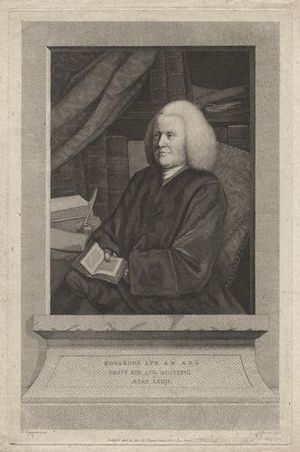Edward Lye facts for kids
Quick facts for kids
Edward Lye
|
|
|---|---|

Engraving of Edward Lye by Thomas Burke (1784), after a portrait by Frances Reynolds.
|
|
| Born | 1694 |
| Died | August 27, 1767 Yardley Hastings
|
| Nationality | British |
| Alma mater | Hart Hall, Oxford |
| Known for | Fellow of the Society of Antiquaries. |
Edward Lye (1694–1767) was an important British scholar from the 1700s. He spent his life studying old languages like Old English and Gothic. His most famous work was a dictionary that helped people understand these ancient languages better.
Contents
Edward Lye's Life and Career
Early Life and Education
Edward Lye was born in 1694 in a town called Totnes, in Devon, England. His father, Thomas Lye, was a schoolmaster and also a vicar (a type of church leader). Edward went to his father's school in Totnes and later to Crewkerne school in Somerset.
He then went to Hart Hall, Oxford, which is part of Oxford University. He started there in 1713 and earned his first degree in 1716. He got his master's degree in 1722.
Becoming a Church Leader and Scholar
In 1717, Edward Lye became a priest. In 1721, he was made the vicar of a church in Houghton Parva, Northamptonshire.
He was very interested in history and old things. In 1750, he was chosen to be a Fellow of the Society of Antiquaries. This is a group for people who study history and ancient objects. Around the same time, he left his church in Houghton Parva. He became the rector (another type of church leader) of Yardley Hastings, also in Northamptonshire. At this time, he was also supporting his mother and two sisters.
Later Years and Legacy
Edward Lye suffered from a long-term illness called gout. He passed away at the age of 73 on August 19, 1767, in Yardley Hastings. He was buried there, and a special monument was placed on the wall to remember him. After he died, his collection of books was sold in 1773.
Edward Lye's Important Works
Studying Old Languages
Edward Lye loved studying old languages, especially Anglo-Saxon and other related languages. Old English is the earliest form of the English language, spoken in England from about 450 to 1150 AD.
In 1743, he published an updated version of a book called Etymologicum Anglicanum. This book was originally written by Francis Junius. Edward Lye added his own notes and an Anglo-Saxon grammar to it. A grammar book explains the rules of a language.
Creating Dictionaries
In 1750, he worked on a book about the Gothic language. Gothic was an ancient Germanic language spoken by the Goths. His book included a Gothic version of the gospels (parts of the Bible), a Latin translation, and a Gothic grammar.
Around 1737, Lye started working on a huge dictionary of Anglo-Saxon and Gothic words. He wasn't sure if he would ever be able to publish it. But in 1765, he received financial support from important people like Archbishop Thomas Secker. This encouraged him to continue.
Sadly, Edward Lye died before his dictionary was fully printed. However, his friend Owen Manning finished the work. The dictionary was published in 1772, after Lye's death. It was called Dictionarium Saxonico et Gothico-Latinum. This dictionary was a major step forward in understanding Old English. It helped many scholars who came after him, including Joseph Bosworth, who created an even bigger dictionary in 1838.

